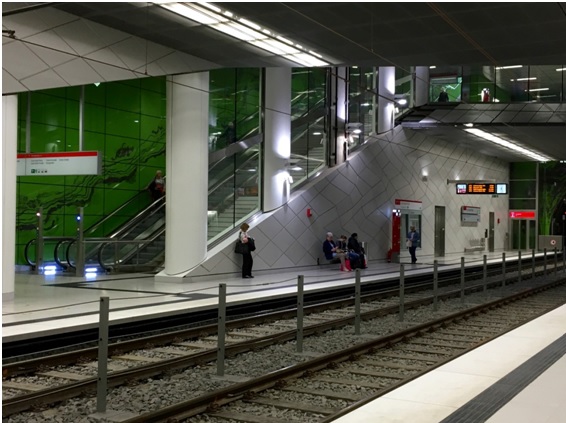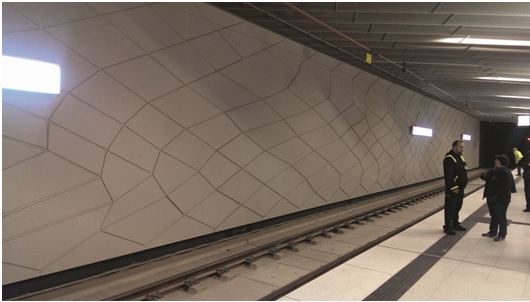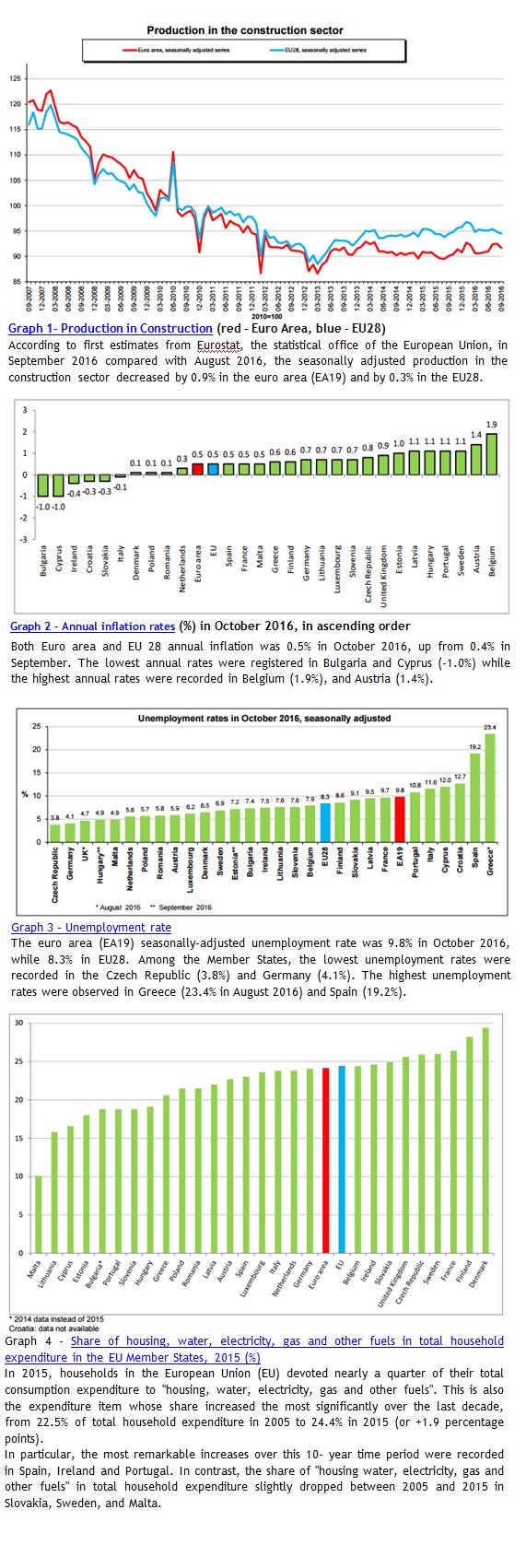Concrete Perspectives November-December 2016
Construction Sector
- On 24 November, Fire Safe Europe launched a campaign to call the European Commission to act on Fire Safety. Currently there is no coordinated approach to fire prevention and response across Member States, and fire safety is not yet part of the EU policy-making.
Therefore an alliance of fire-fighters, researchers, fire engineers, associations and industry representatives signed the call to action and ask the European Commission to address this urging and important issue. While there is no harmonized European Fire Safety Policy, European citizens do not have the same chances of survival when a building catches fire. To illustrate this case, Fire Safe Europe prepared a video with two teams to participate in an escape game while simulating a fire with an uneven level of fire safety.
- DG GROW (Internal Market, Industry, Entrepreneurship and SMEs) is developing a “building passport” proposal for the end of 2017. The Commission is currently gathering information whether to go ahead and develop the project or not. A building passport would mean to list every single construction product in the building.
The first meeting was held at the end of September 2016 when they discussed the scope and function of a building passport, data transparency and reliability, and existing national initiatives.
The European Commission aims to have a step-by-step approach with:
- component to a system level data;
- performance measurements;
- property valuation.
The second meeting will take place early 2017 and Construction Products Europe is engaging with the developers of the project and other stakeholders of the construction sector.
- On 17 November, the Concrete Initiative held its annual Concrete Dialogue event with more than 100 participants. The event was a great success with good roundtable discussions and with a dynamic interactive feedback session. Pictures, presentations and reports can be found here.
- On 10 November, the European Policy Centre held an event entitled on Energy Union and construction: could energy efficient buildings be an untapped source of prosperity in Europe? Elżbieta Bieńkowska, European Commissioner for Single Market, Industry, Entrepreneurship and SMEs gave a speech about “Energy Union and Construction: the opportunity we must seize”. Her speech can be found here.
In her speech she added that the Commission assessed the implementation of the Construction Products Regulation and there is way for improvement (especially on harmonised standards and market surveillance), therefore it foresees the possible revision of CPR in the course of 2018.
- On 9 December, the European Concrete Platform (ECP) officially joined Fire Safe Europe as full member. As representative of the concrete industry, the ECP identified fire safety as one of its top priorities due to the inherent characteristic of our material and of its durability. While fire safety is a priority for the ECP, it recognizes that the debate is wider than the concrete industry alone and that it affects policies at both national and European level. Being in the Board of Fire Safe Europe will allow the concrete sector to further promote the importance for saving human lives thanks to a resilient and incombustible building fabrics (envelope).

Live from the European Union
European Commission’s Work Programme 2017
The European Commission issued its Work Programme for 2017 with the title “Delivering a Europe that protects, empowers and defends”. The programme has 21 key initiatives to implement 10 political priorities.
- New boost for jobs, growth and investment
- Connected digital single market
- A Resilient Energy Union with a Forward-Looking Climate Change Policy
- A Deeper and Fairer Internal Market with a Strengthened Industrial Base
- A Deeper and Fairer economic and monetary union
- Trade: A reasonable and Balanced Free Trade agreement with the U.S.
- An Area of Justice and Fundamental Rights Based on Mutual Trust
- Towards a new policy on migration
- A Stronger Global Actor
- A Union of Democratic Change
Amongst these priorities there are several initiatives that are directly relevant for the construction sector and some priorities are hiding a lot of opportunities as well.
The third big priority about the Energy Union and climate change policy is directly relevant for our sector. The European Commission issued the “Clean Energy for all Europeans” package on 30 November with important legislations including amongst others, the long-awaited revision of the Energy Performance of Building Directive, the Energy Efficiency Directive and the Renewable Energy Directive.
The initiative closely linked to this priority is the “Implementation of the Energy Union Strategy: low emission travel and mobility” which will have further impact for the construction sector and as well as urban planning.
Another relevant initiative, linked to growth and jobs, is the “Implementation of the Action Plan on Circular Economy”. This will include:
- A non-legislative strategy on plastics use, reuse and recyling to be presented in the last quarter of 2017;
- A proposal for a Regulation on minimum quality requirements for reused water;
- REFIT[1] revision of the Drinking Water Directive
The third relevant initiative is the “Modernisation of the Comitology procedure” (linked to the priority Union of Democratic Change). EC will assess the legitimacy of existing procedures for the adoption of delegated and implementing acts during the first quarter of next year (relevant for the future revision of Construction Products Regulation).
European Commission issues integrated “Energy Package”
On 30 November the European Commission issued the long-awaited and much anticipated Energy package (“Clean Energy for All Europeans”) which contains important initiatives, including proposed revisions of the Directives on Energy Performance of Buildings (EPBD), Energy Efficiency (EED) and Renewable Energy, and a European Buildings Initiative (smart financing for smart buildings).
The Commission aims to achieve goals on cutting emissions and adapt Europe’s grid to a rise of digital technologies and growth of wind and solar power that is transforming industry and challenging utilities. Additionally, the package also aims at reducing energy prices and modernizes billing.
The European Commission proposes a binding 2030 energy efficiency target of 30% and an extension of the EED’s main provisions, Article 7, until 2050.
Furthermore, the reference to thermal capacity is maintained in the new proposal of the EPBD. Besides, there are new provisions for “smart readiness” including demand response (interaction with the grid) and energy storage and flexibility. The Concrete Initiative welcomes the “smart indicator” and the recently published 3 study confirms that heavyweight buildings can provide this flexibility. By storing thermal energy, the consumer’s energy demand can be shifted in time, which results in up to a 25% CO2 reduction per dwelling, up to 50% reduction in the need for peak electricity supply capacity and savings of up to €300 per household per year.
European Commission – Press Release
The Concrete Initiative – Energy efficient and low CO2 buildings
The Concrete Initiative – Thermal mass fact sheet
[1] Regulatory Fitness and Performance Programme (REFIT) aims at making sure that EU laws deliver their intended benefits for citizens, businesses and society while removing red tape and lowering costs. It also aims to make EU laws simpler and easier to understand.
National Award Winner
Wehrhahn-Line Subway (Dusseldorf, Germany)
(This case study can be found in original version on the website of The Concrete Initiative http://www.theconcreteinitiative.eu/case-studies/216-wehrhahn-line-subway )
The Wehrhahn-Line an exceptional group achievement that opened in Düsseldorf in February 2016, as a new subway line (3.4 km) across Düsseldorf city centre. In Düsseldorf, this is the biggest transport construction scheme since the completion of the Rhine River tunnel in 1993. The project was completed after 15 years of planning and construction, with architects, artists, engineers, and the city administration working side-by-side.

The project was launched with an international competition in 2001. From 70 entries, Darmstadt-based architect and artist Heike Klussmann were selected to design the project. In the award-winning design, architecture and art are inseparable, complementing one another as they extend as an ensemble from the surface down to the train platforms. The design is like a snake winding its way through the soil and widening out at the stations. In the transition from surface to underground, identifiable “cut spaces” were created on the wall, each of them distinguishable with a unique identity (2700 different formats).

The skilful interplay of engineering expertise and art has succeeded in making the Wehrhahn-Line an exemplary and innovative contribution to the city infrastructure, one that now offers Düsseldorf’s residents and visitors an exceptional opportunity to “experience space” in local urban transit.
The art concept is based on an outstanding construction of precast elements in high-performance concrete cast stone, with individually computer integrated manufacturing.

Key Facts:
Country: Germany
Project: Kontinuum Wehrhahn-Linie Düsseldorf
Year of completion: 2016
Floor area: 4000 m2
Architectural design: netzwerkarchitekten GmbH, Prof. Heike Klussmann & Universität Kassel
Contractor: Federal Capital of Nordrhein-Westfalen Düsseldorf
Cast stone (as wall cladding): Schwab-Stein GmbH Betonsteinwerk
Aggregates: “Nordisch Weiß” and crystalline silica
High-perfomance-binder: Flowstone white by Dyckerhoff
Pigmentes: synthetic iron-oxide
News in brief

Agenda
JANUARY 2017
18 January 2017
EU Technical Platform on simplified labels
Brussels, Belgium
18 January 2017
AhG Concrete Initiative
Brussels, Belgium
30 January 2017
ECP TF Sustainable Concrete
Web-meeting
31 January 2017
IMCO hearing on CPR
European Parliament, Belgium
31 January 2017
EMA Dinner with MEPs
Brussels, Belgium
FEBRUARY 2017
1 February 2017
CEN/TC 104/TG 20
Brussels, Belgium
2-3 February 2017
ECO-Binder General Assembly
BRE Watford, UK
10 February 2017
CPE – TG Implementation of CPR
Confcall
13 February 2017
Directors meeting
Neu-Ulm, Germany
MARCH 2017
8 March 2017
BIBM Technical Commission
Brussels, Belgium
13-14 March 2017
VEEP Board
Genoa, Italy
15 March 2017
ECP Board
Brussels, Belgium
22 March 2017
BIBM Environment Commission
Brussels, Belgium
To the Newsletter of Construction Products Europe (former CEPMC), please follow this link.
To read the Newsletter of CEMBUREAU, please follow this link. You can also subscribe directly following this link http://www.cembureau.eu/newsletter/subscriptions.
To read the Quarterly Newsletter of The Concrete Initiative, please follow this link.
List of Acronyms:
CPE – Construction Product Europe
DG GROW – Directorate-General for Internal Market, Industry, Entrepreneurship and SMEs
ECP – European Concrete Platform
EMA – European Masonry Alliance
IPHA – International Pre-stressed Hollowcore Association
TF – Task Force
